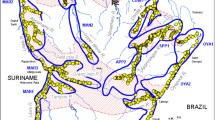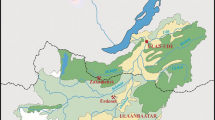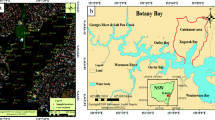Abstract
Road sediments from gully pots of the drainage system and stream sediments from local streams were investigated for the first time in the urban area of Idrija town, the central part of the second largest and strongly contaminated Hg mining district in the world. Hg concentrations in road sediments were lower than in stream sediments. They ranged from 16 to 110 mg/kg (Md = 29 mg/kg) for <0.125 mm particles and from 7 to 125 mg/kg (Md = 35 mg/kg) for <0.04 mm particles, while Hg concentrations in stream sediments ranged from 10 to 610 mg/kg (Md = 95 mg/kg) for <0.125 particles and from 10 to 440 mg/kg (Md = 105 mg/kg) for <0.04 mm particles. High Hg loadings in stream sediments were successfully linked with identified mercury sources (rocks containing mercury ore, areas of former ore roasting sites, ore residue dumps), because they are located in the drainage areas of streams, from which the sediments were collected. Links between Hg loadings in road sediments and identified mercury sources were not recognized. Solid phases of Hg were determined by thermo-desorption technique and are similar for both types of sediments. Results show the occurrence of three different forms: elemental mercury, mercury bound to matrix components and cinnabar. Approximately 50 % of Hg in samples consist of non-cinnabar fractions. This is important, since they are potentially bioavailable. An interesting new discovery according to previous research of environmental media from Idrija area by solid-phase Hg thermo-desorption technique is that elemental mercury was determined in almost all investigated sediments in minor amounts (Md = 3 %).






Similar content being viewed by others
References
Biester, H., Gosar, M., & Covelli, S. (2000). Mercury speciation in sediments affected by dumped mining residues in the drainage area of the Idrija mercury mine. Slovenia. Environmental Science and Technology, 34(16), 3330–3336.
Biester, H., Gosar, M., & Müller, G. (1999). Mercury speciation in tailings of the Idrija mercury mine. Journal of Geochemistry Exploration, 65(3), 195–204.
Biester, H., Hess, A., & Müller, G. (1996). Investigations on different mercury-phases in soils of a Hg-mining area by a temperature-controlled-pyrolysis technique. In R. Reuter (Ed.), Geochemical approaches for the environmental engineering of metals (pp. 33–43). Berlin Heidelberg: Springer.
Biester, H., & Nehrke, G. (1997). Quantification of mercury in soils and sediments: Acid digestion versus pyrolysis. Fresenius’ Journal of Analytical Chemistry, 358, 446–452.
Biester, H., & Scholz, C. (1996). Determination of mercury binding forms in soils: mercury pyrolysis versus sequential extraction. Environmental Science and Technology, 31(1), 233–239.
Burton, G. A, Jr. (2002). Sediment quality criteria in use around the world. Journal of Limnology, 3, 65–75.
Čar, J. (1998). Mineralized rocks and ore residues in the Idrija region. In V. Miklavčič (Ed.), Proceedings of the meeting of researchers entitled: Idrija as a natural and anthropogenic laboratory, Mercury as a major pollutant (pp. 10–15). Mercury mine Idrija: Idrija.
Dizdarevič, T. (2001). The influence of mercury production in Idrija mine on the environment in the Idrija region and over a broad area. RMZ: Materials and Geoenvironment, 48(1), 56–64.
EN ISO 14688-1:2002: Geotechnical investigation and testing—Identification and classification of soil: Part 1: Identification and description (ISO 14688-1:2002).
Feng, X., Lu, Y. J., Grègoire, D. C., Hao, Y., Banic, M. C., & Schroeder, H. W. (2004). Analysis of inorganic mercury species associated with airborne particulate matter/aerosols: Method development. Analytical and Bioanalytical Chemistry, 380(4), 683–689.
Gosar, M. (1997). Mercury in sediments and air as a reflection of Idrija mineralization and mining. Ljubljana: Dissertation University of Ljubljana.
Gosar, M. (2008). Mercury in river sediment, floodplains and plants growing thereon in drainage area of Idrija mine Slovenia. Polish Journal of Environmental Studies, 17(2), 227–236.
Gosar, M., & Čar, J. (2006). Influence of mercury ore roasting sites from sixteenth and seventeenth century on the mercury dispersion in surroundings of Idrija. Geologija, 49(1), 91–101. doi:10.5474/geologija.2006.007.
Gosar, M., Pirc, S., & Bidovec, M. (1997a). Mercury in the Idrijca River sediments as a reflection of mining and smelting activities of the Idrija mercury mine. Journal of Geochemical Exploration, 58, 125–131.
Gosar, M., Pirc, S., Šajn, R., Bidovec, M., Mashayanov, N. R., & Sholupov, S. E. (1997b). Distribution of mercury in the atmosphere over Idrija, Slovenia. Environonmental Geochemistry and Health, 19, 101–110.
Gosar, M., & Šajn, R. (2001). Mercury in soil and attic dust as a reflection of Idrija mining and mineralization (Slovenia). Geologija, 44(1), 137–159. doi:10.5474/geologija.2001.010.
Gosar, M., Šajn, R., & Biester, H. (2006). Binding of mercury in soils and attic dust in the Idrija mercury mine area (Slovenia). Science of Total Environment, 369(1–3), 150–162.
Gosar, M., & Žibret, G. (2011). Mercury contents in the vertical profiles through alluvial sediments as a reflection of mining in Idrija (Slovenia). Journal of Geochemical Exploration, 110(2), 81–91.
Gray, J. E., Hines, M. E., Higueras, P. L., Adatto, I., & Lasorsa, B. K. (2004). Mercury speciation and microbial transformations in mine wastes, stream sediments, and surface waters at the Almáden mining district, Spain. Environmental Science and Technology, 38, 4285–4292.
Hess, A. (1993). Verteilung, Mobilität und Verfügbarkeit von Hg Böden und Sedimenten am Beispiel zweier hochbelasteter Industriestandorte (Vol. 71). Heidelberg: Heidelberg Geowissenschaftliche Abhandlungen.
Hojdová, M., Navrátil, T., & Rohovec, J. (2008). Distribution and speciation of mercury in mine waste dumps. Environmental Contamination and Toxicology, 80(3), 237–241.
Kavčič, I. (1974). Kakšna je stopnja onečiščenosti zraka v Idriji. Idrijski razgledi, 9(1–2), 25–29.
Kavčič, I. (2008). Živo srebro: Zgodovina idrijskega žgalništva. Založba Bogataj: Idrija.
Kocman, D., & Horvat, M. (2010). A laboratory based experimental study of mercury emission from contaminated soils in the River Idrijca catchment. Atmospheric Chemistry and Physics, 9(6), 1417–1426.
Kocman, D., Kanduč, T., Ogrinc, N., & Horvat, M. (2011a). Distribution and partitioning of mercury in a river catchment impacted by former mercury mining activity. Biogeochemistry, 104, 183–201.
Kocman, D., Vreča, P., Fajon, V., & Horvat, M. (2011b). Atmospheric distribution and deposition of mercury in the Idirja Hg mine region Slovenia. Environmental research, 111(1), 1–9.
Kosta, L., Byrne, A. R., Zelenko, V., Stegnar, P., Dermelj, M., & Ravnik, V. (1974). Studies on the uptake, distribution and transformations of mercury in living organisms in the Idrija region and comparative areas. Vestnik slovenskega kemijskega društva, 21, 49–76.
Kotnik, J., Horvat, M., & Dizdarevič, T. (2005). Current and past mercury distribution in air over the Idrija Hg mine region Slovenia. Atmospheric Environment, 39(38), 7570–7579.
Dean J.D., & Mason, PR (2009) Estimation of mercury bioaccumulation potential from wastewater treatment plants in receiving waters: Phase 1. Report No. 05-WEM-1CO, Water Environment Research Foundation, Alexandria (VA).
MHSPE: Ministry of Housing, Spatial Planning, and the Environment (2013) The New Dutch List. In: Intervention values and target values: Soil quality standards. Directorate general for environmental protection, Department of soil protection, The Hague, The Netherlands. http://www.contaminatedland.co.uk/std-guid/dutch-l.htm. Accessed 25 Apr 2013.
Mlakar I., & Čar J. (2009) Geological map of the Idrija: Cerkljansko hills between Stopnik and Rovte 1:25.000. Ljubljana, Geološki zavod Slovenije.
Mlakar I., & Čar J. (2010) Geological structure of the Idrija—Cerkljansko hills: Explanatory Book to the Geological map of the Idrija—Cerkljansko hills between Stopnik and Rovte 1:25.000. Ljubljana, Geološki zavod Slovenije.
Mulligan N.C., Fukue M., & Sato Y. (2009) Sediment Contamination and Sustainable Remediation. CRC Press.
Navarro, A. (2008). Review of characteristics of mercury speciation and mobility from areas of mercury mining in semi-arid environments. Reviews in Environmental Science and Bio/Technology, 7(4), 287–306.
NMSs: National Meteorological Service of Slovenia (2012) Ministry of Agriculture and Environment: Slovenian Environment Agency. http://meteo.arso.gov.si/met/sl/archive/. Accessed 27 Dec 2012.
Rytuba, J. J. (2003). Mercury from mineral deposits and potential environmental impact. Environmental Geology, 43(3), 326–338.
Salminen R., Batista M.J., Bidovec M., Demetriades A., De Vivo B., De Vos W., Duris M., Gilucis A., Gregorauskiene V., Halamic J., Heitzmann P., Lima A., Jordan G., Klaver G., Klein P., Lis J., Locutura J., Marsina K., Mazreku A., O’Connor P.J., Olsson S.Å., Ottesen R.T., Petersell V., Plant JA., Reeder S., Salpeteur I., Sandström H., Siewers U., Steenfelt A., & Tarvainen T. (2005) Geochemical Atlas of Europe. Part 1- Background Information, Methodology and Maps. Geological survey of Finland.
Skyllberg, U. (2010). Mercury transformations in wetland soils in relation to C, S and Fe biogeochemistry. In R. J. Gilkes & N. Prakongkep (Eds.), Proceedings of the 19th world congress of soil science: Soil solutions for a changing world (pp. 44–47). Brisbane, Australia: International Union of Soil Sciences.
Skyllberg U. (2011) Chemical speciation of mercury in soil and sediment. In: G. Liu, Y. Cai, N. O’Driscoll (Ed.) Environmental chemistry and toxicology of mercury (pp. 219–258). New Jersey, John Wiley & Sons.
Taylor, G. K., & Owens, N. P. (2009). Sediments in urban river basins: A review of sediment-contaminant dynamics in an environmental system conditioned by human activities. Journal of Soils and Sediments, 9, 281–303.
Teršič, T. (2010). Environmental influences of historical small scale ore processing at Idrija area. Ljubljana: Dissertation University of Ljubljana.
Teršič, T., & Gosar, M. (2009). Preliminary results of detailed geochemical study of mercury at the ancient ore roasting site Pšenk (Idrija area, Slovenia). Geologija, 52(1), 79–86. doi:10.5474/geologija.2009.009.
Teršič, T., & Gosar, M. (2012). Comparison of elemental contents in earthworm cast and soil from a mercury-contaminated site (Idrija area, Slovenia). Science of Total Environment, 430, 28–33.
Teršič, T., Gosar, M., & Biester, H. (2011a). Environmental impact of ancient small-scale mercury ore processing at Pšenk on soil (Idrija area, Slovenia). Applied Geochemistry, 26(11), 1867–1876.
Teršič, T., Gosar, M., & Biester, H. (2011b). Distribution and speciation of mercury in soil in the area of an ancient mercury ore roasting site, Frbejžene trate (Idrija area, Slovenia). Journal of Geochemistry Exploration, 110(2), 136–145.
Wiener, J. G., & Suchanek, T. H. (2008). The basis for ecotoxicological concern in aquatic ecosystems contaminated by historical mercury mining. Ecological Applications, 18(8), A3–A11.
Žibret, G., & Gosar, M. (2005). What is the amount of mercury accumulated in the Idrijca River overbank sediments? Geologija, 48(1), 97–105. doi:10.5475/geologija.2005.009.
Žibret, G., & Gosar, M. (2006). Calculation of the mercury accumulation in the Idrijca River alluvial plain sediments. Science of Total Environment, 368(1), 291–297.
Acknowledgments
The presented study was funded by the Slovenian Research Agency (ARRS) in the frame of the research programme Groundwater and Geochemistry (P1-0020), which is performed by the Geological Survey of Slovenia. The authors would like to thank Vesna Miklavčič, Msc., director and Martin Kržišnik from Komunala Idrija for advices and good cooperation during sampling of urban sediments.
Author information
Authors and Affiliations
Corresponding author
Rights and permissions
About this article
Cite this article
Bavec, Š., Biester, H. & Gosar, M. Urban sediment contamination in a former Hg mining district, Idrija, Slovenia. Environ Geochem Health 36, 427–439 (2014). https://doi.org/10.1007/s10653-013-9571-6
Received:
Accepted:
Published:
Issue Date:
DOI: https://doi.org/10.1007/s10653-013-9571-6




